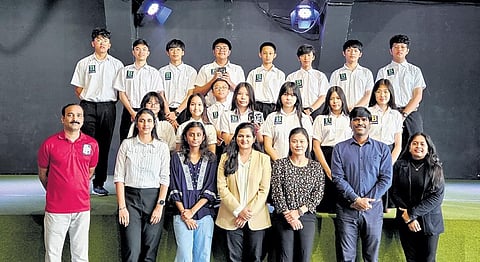

GUNTUR: After the historic success of Vikram-S, India’s first privately developed rocket launch, Sai Divya Kurapati, the mastermind behind one of its payloads, is gearing up to launch another CubeSat BWSAT on October 4 from Spain. It can be recalled, Vikram-S was successfully launched into space on November 18, 2022 and Sai Divya’s CubeSat LakshyaSAT II is one of the three payloads.
Working as a research scholar in Satellite Communications and hailing from Tenali in Guntur district, Sai Divya was an engineering graduate in Electronics and Communications Engineering from Bapatla Engineering College and completed her MTech specialising in Communication and Radar Systems. She set up her own space tech company called ‘N Space Tech’ in Tenali and has been aiming to build affordable satellites that are easily deployable, bringing space technology to the masses.
LakshyaSAT I, her first CubeSat, was launched successfully into the stratosphere from the United Kingdom in March 2022. The recent BWSAT, placed inside a space box platform will be sent to the stratosphere to collect various parameters of the atmosphere with the help of a high-altitude balloon.
As many as six sensors have been set up to measure temperature, pressure humidity, altitude, CO2, magnetic strength and collect flight data. Along with these, two camera payloads for image and video, a GPS payload have been set up.
Explaining the reason for adding these extra payloads, Divya said, “Though we get images and videos from the camera attached to the balloon, I wanted to check the size of the files when the view is from the satellite as these payloads will be included in the CubeSat for the upcoming lower earth orbital mission in Vikram 1.
If the size of the file is high, we have to modify the communication system parameters and get an overall idea. Through GPS payload, we can identify the changes in temperature, pressure, and other parameters at exact coordinates. The data from the BWSAT can be used to compare with the existing data sets, validate data with existing data, and measure the accuracy of the components.”
The estimated height of BWSAT is 25 km and the exact height can be known after the launch. Depending on the atmospheric conditions, the BWSAT will be launched either on October 4 or 6 from the B2Space company launch station in Spain.
“While the flight time of LakshyaSAT 1 is over three hours, due to wind velocity and other factors, we are predicting that the flight time will be only over one hour in order to prevent it from going missing,” she added.
Saying that BWSAT is close to her heart, Divya said, “I always wanted to interact with children and inspire young minds through these nanosatellites and it became possible through this project.”
During the beginning of the project in June this year, Haribabu Kalidasu, a native of Tenali and also administrative head of the Brainworks International School in Myanmar, contacted Divya and requested her to conduct an interactive session with the students. Over 15 sessions were conducted with the students and every phase of building the prototype including all the subsystems, payload, computing, power, and data logging was done along with them.